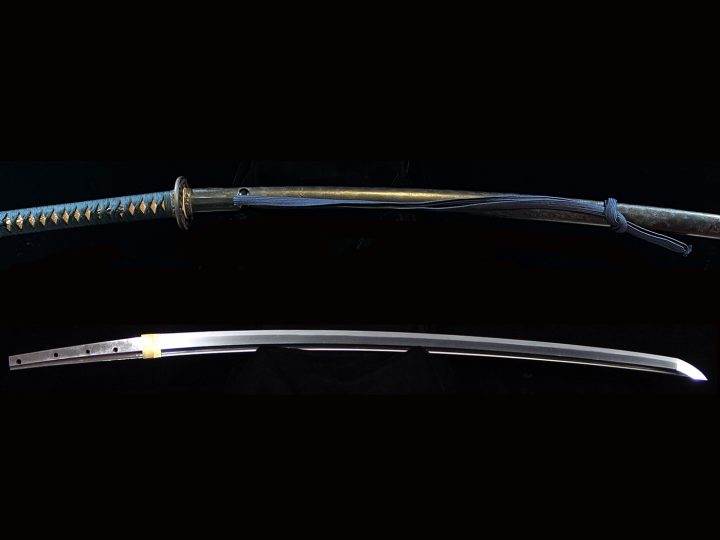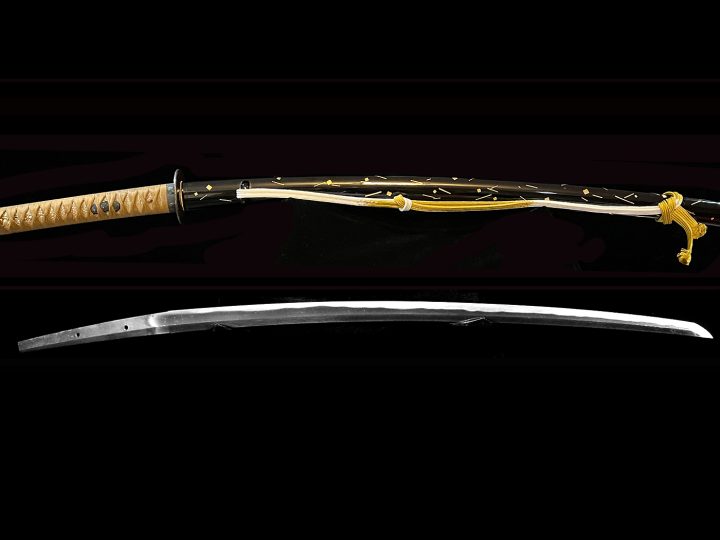
This a very interesting tachi by the Bizen smith, Morisuke. It is signed Bishû Osafune Jû Morisuke (備州長船住守助). It is dated Kenmu ni-nen ni-gatsu hi (建武二年二月日) meaning a day in the 2nd month, the 2nd year of Kenmu or 1335. What makes this tachi especially important is the fact that it is ubu (un-shortened) and in excellent condition. The fact that it also bears numerous battle scars from the turbulent Nanbokucho Era of its early life adds unlimited charm and historical significance.
From the signature, Morisuke (守助) is an Osafune sword-smith, however, it is not clear to which lineage he belongs. There is not a lot written about him. However, in one reference I did find him listed as a smith of the Kozori (小反) school. The Kozori (小反) were a group of smiths among the Osafune smiths that were active during the Nanbokucho Era and into the Muromachi Era but the literal meaning of Kozori (小反) is not certain.
A book written by Hasegawa Chuemon Naotsugu says “Kozori (小反) smiths lived in Osafune and Shigeyoshi and Morihisa founded the group”. They demonstrate a similar workmanship to that of Kanemitsu (兼光). Their hamon is tempered in a smaller pattern than that of Kanemitsu (兼光) and Motoshige (元重). As a whole, they are inferior to Kanemitsu (兼光) in skill and nie is more emphasized.”
Since the resemblance to Kanemitsu (兼光) is a well known attribute of the Kozori (小反) school and also the subject sword, perhaps a few words about Kanemitsu (兼光) and his works are in order at this point.
Bizen Kanemitsu (備前兼光) was the son of Bizen Kagemitsu (備前景光) who was the son of Bizen Nagamitsu (備前長光). He was also the great-grandson of the founder of the Bizen Osafune School, Mitsutada (光忠). A blade dated 1331 is the oldest dated example of the work of Kanemitsu (兼光). As has been noted, the date of the subject blade by Morisuke (守助) is Kenmu ni-nen ni-gatsu hi (建武二年二月日) meaning a day in the 2nd month, the 2nd year of Kenmu or February of 1335. While this clearly shows that Morisuke (守助) was a contemporary of Kanemitsu (兼光), we do not know if this is an early blade by Morisuke (守助) or a later one. It is, however, the earliest dated example that I have been able to find. Also, we do have several tanto with the same signature of Morisuke (守助) on blades dated 1339, 1353, 1354, 1361, and two dated 1363. According to the Nihontô Meikan the blades made during the Enbun Era (1356) and later are attributable to the second generation Morisuke(二代守助). While this means that we should consider the Shodai Morisuke (初代守助)to have been active only until about 1360, it also clearly indicates that he was a contemporary of Kanemitsu (兼光) and that they certainly shared a mutual influence.
Kanemitsu’s (兼光) works from 1331 until the Kôei era (康永) (1342-1344) resemble those of his father, Kagemitsu (景光). Kagemitsu’s (景光) sugata shows features typical of the late Kamakura period with hamon that are uniformly kataochi gunome consisting of nioi with a mixing in of square-shaped gunome, and there are such activities as minute ashi and yô. This is interesting because many of these traits are found in the subject blade by Morisuke(守助). Morisuke’s (守助) tachi has the distinctive kataochi gunome, ko- itame hada mixed with a flowing hada, and there is midare utsuri.
Most of Kanemitsu’s (兼光) long swords have been shortened with the original nakago being lost, but on those ubu examples that exist the nakago will be long with a slight curvature and a ha-agari-kurijiri. The yasurimei will be katte-sagari. Again, we can draw direct parallels to the nakago of the subject blade by Morisuke (守助).
Beginning around the Kôei era 康永 (1342-1344), the workmanship of Kanemitsu (兼光) changed markedly. After this period, tachi with prolonged kissaki together with tantô, and wakizashi with markedly stretched width and length came into existence. The notare hamon that was first introduced about this time came to gain popularity by the Bunwa and Enbun days 文和—延文 (1352-1360). The works produced in and after the Kanô 觀応(1350-1351) days began to show elements of Sôshû influence mixed with the normal Bizen style.
If we are to take these dates of the change in workmanship style of Kanemitsu (兼光) as factual, we can make several interesting observations about Kanemitsu (兼光) vs. Morisuke (守助). The traditional date for the beginning of the Nanbokucho era is 1331, therefore the time period between 1335 (when the Morisuke (守助) tachi is dated) and 1342 (thought to be the time when the workmanship of Kanemitsu (兼光) changed) was a period of profuse change in both the political arena and in the manufacture of swords.
The shape and workmanship of the Morisuke (守助) tachi resembles the hataraki of Kanemitsu’s (兼光) early period and the shape of his later period. In other words, the workmanship resembles that of Kanemitsu (兼光) when he was still emulating the works of his father Kagemitsu (景光) with the kataochi gunome choji, deep koshi zori sugata, etc. Yet the overall size of the sugata of the Morisuke (守助) tachi cannot be called anything other than typical of the Nanbokucho era and resembling the work of Kanemitsu (兼光) during his Enbun period. An exception to this sugata would be the kissaki in that it is medium sized and not the o-kissaki of Kanemitsu’s (兼光) Nanbokucho style. We must keep in mind that this was a transition period so we would expect the waters to be somewhat muddied.
We know the direction Kanemitsu (兼光) went going forward into the Nanbokucho era due the the great many examples of his works that survive today. This brings us back to the Kozori (小反) school as being an offshoot of the traditional Osafune school and more particularly, the Osafune school as embodied by Kanemitsu (兼光).
In all fairness, I must admit that, as I said at the beginning of this article, I found only one reference that specifically placed Morisuke (守助) into the Kozori (小反) school. In point of fact the Nihontô Taikan does not mention the Kozori (小反) school in their write-up of either generation of Morisuke (守助).
Be that as it may, if we examine the tanto that were made by Morisuke (守助) in 1339, 1353, and 1354, we find definite Kozori (小反) characteristics such as a gunome hamon like Kanemitsu yet tempered in a noticeably smaller pattern. Since the Kozori (小反) school continued throughout the Nanbokucho era and Morisuke (守助) worked more toward the beginning of that period, we should expect to find differences between his works and what was to become more traditional Kozori (小反) workmanship later.
Once again, since we are not blessed with an abundant number of remaining signed examples of the works of Morisuke (守助), much of what we say today is conjecture. It is totally within the realm of possibilities that Morisuke started out in the traditional Osafune school along with Kanemitsu (兼光) and later gravitated toward the Kozori (小反) school just as Kanemitsu (兼光) traveled his own path into the Soden Bizen tradition. What we can be sure of, however, is what lies before us. That is an ubu tachi of massive proportions that has withstood multiple battles and the test of time for almost 700 years. It exhibits characteristics that make it an important example of a transitional time between the slender and graceful tachi of the Kamakura era and the massive and oversized nodachi of the Nanbokucho era.
This tachi not only has the size, grace and strength of those turbulent times, but it also proudly wears its scars from numerous battles. There is a massive cut in the ha about 4 3/8 inches or 11.2 cm from the hamachi. Also, there are the remnants of multiple sword cuts along the mune especially in the monouchi area. The fact that it has survived all this battle damage attests to the quality of the blade and its ability to take punishment and to keep on performing.
This sword shown above was awarded Jûyô Tôken status in Shôwa 48 (1973). Here is a translation of the Jûyô zufu:
Designated Jûyô Tôken at the 21st Shinsa of March first, the 48th year of Shôwa (1973)
Tachi, signature: Bishû Osafune jû Morisuke; Kenmu ni-nen ni-gatsu hi [備州長船住守助; 建武二年二月日] (a day in the 2nd month, the 2nd year of Kenmu, 1335).
Measurements: Length: 87.7 cent.; Curvature: 3.8 cent.; Width at Base: 3.5 cent.; Width at Point: 2.0 cent.; Kissaki Length: 3.8 cent.; Nakago Length: 28.0 cent.; Nakago Curvature: 0.3 cent.
Characteristics: The construction is shinogi-zukuri with an iori-mune. The blade is long and wide with high koshi-zori. There is funbari and a chû-kissaki. The kitae is ko-itame-hada with a mixing in of flowing hada. The jigane contains conspicuous midare-utsuri. The hamon is gunome-midare with a mixing in of kataochi style gunome. There is ashi and yô activity. The bôshi is sugu with a ko-maru. The nakago is ubu, and the end is kurijiri. The yasurime are katte sagari. There are two mekugi-ana, and there is a long inscription on the hakiomote above the mekugi-ana and near the mune with a date in the same area on the ura.
Explanation: This is a typical ô-dachi of the Nambokuchô period, and the fact that is ubu, signed and dated is delightful. Although from the signature Morisuke is an Osafune sword-smith, it is not clear to which lineage he belongs. In addition to this blade, there are several other hira-zukuri sun-nobi tantô.







